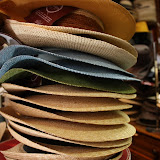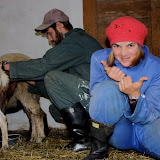Seeing More Than Just Mountains
Monday, December 07, 2009 by Annie
The best way to see Nepal is with a little elevation. The Himalayan mountains run the length of this tiny country and make up a good deal of its hot spots. We were able to spend some quality time in the heart of them while circumnavigating the Annapurna mountains and then making our way into base camp surrounded on three sides by some of the highest peaks in the world. The beginning of this trip started with some careful planning in Kathmandu to determine a route and most importantly a suitable guide. After interviewing four guides, we're very thorough you know, we found our match and were feeling good about a twenty two day time frame. Now we just had to do it.
Pradip became our third, crucial, wheel for the next few weeks, a local Nepalese man that has taken a number of groups into the mountains and claims that they have all returned safely. He became our best friend and best local knowledge as we blindly jumped into the world of trekking and up to elevations that our bodies have never experienced. One of the other beautiful things about Pradip was that he carried some our belongings. We did try to keep it to a minimum but when you put Ryan's 80 ltr backpack onto a five foot Nepalese man it looks unproportionally large.... try telling that to other trekkers carrying all of their own stuff! (Brian, Graham, Jen, and a host of others quickly called us out on the trail)
The two greatest aspects of the Annapurna Circuit are 1) hiking through some very old traditional Nepali towns and 2) meeting the people that inhabit them. Every town has its own distinct character and community feel. The building style changes from timber to stone as you get closer to the Tibetan boarder and rise in elevation and the farming style changes
depending on the climate and terrain. We passed through warmer valley regions with lush vegetation and mountain sides of rice terraces, fields of fruit trees. But as we gained elevation the land turned dry and desert like, the vegetables became scarce and hearty yaks took over the countryside. It was neat to watch this climate change in such a short amount of time and how people of these diverse areas lived. Everyone makes the most of what they have. The houses are very minimal with kitchen, bedroom, living space all being in one small area and all generations of families living together. By our societal standards you'd say they are poor and needy but, everyone had a smile on their face and time to look up and say "Namaste." The children seemed to have the best imaginations. When you don't have outside stimulation to rely on, the little things are what keep you entertained. Sometimes a plastic bag full of plastic bags turned into a hacky sack or rocks and marbles make for hours of fun.
On our very last night of the trip we ended up being the only guests at a family's guesthouse in their little riverside town of Syauli Bazar. We joined them in their kitchen to observe the preparation of our meal and chat with them about their lives. So although I was initially more excited about the scenery and aesthetic in store for us along our trek, getting that true glimpse, however short, into the lives of the native Nepalese and their homes, was the real rewarding part of this trek for me.

Pradip became our third, crucial, wheel for the next few weeks, a local Nepalese man that has taken a number of groups into the mountains and claims that they have all returned safely. He became our best friend and best local knowledge as we blindly jumped into the world of trekking and up to elevations that our bodies have never experienced. One of the other beautiful things about Pradip was that he carried some our belongings. We did try to keep it to a minimum but when you put Ryan's 80 ltr backpack onto a five foot Nepalese man it looks unproportionally large.... try telling that to other trekkers carrying all of their own stuff! (Brian, Graham, Jen, and a host of others quickly called us out on the trail)
The two greatest aspects of the Annapurna Circuit are 1) hiking through some very old traditional Nepali towns and 2) meeting the people that inhabit them. Every town has its own distinct character and community feel. The building style changes from timber to stone as you get closer to the Tibetan boarder and rise in elevation and the farming style changes

depending on the climate and terrain. We passed through warmer valley regions with lush vegetation and mountain sides of rice terraces, fields of fruit trees. But as we gained elevation the land turned dry and desert like, the vegetables became scarce and hearty yaks took over the countryside. It was neat to watch this climate change in such a short amount of time and how people of these diverse areas lived. Everyone makes the most of what they have. The houses are very minimal with kitchen, bedroom, living space all being in one small area and all generations of families living together. By our societal standards you'd say they are poor and needy but, everyone had a smile on their face and time to look up and say "Namaste." The children seemed to have the best imaginations. When you don't have outside stimulation to rely on, the little things are what keep you entertained. Sometimes a plastic bag full of plastic bags turned into a hacky sack or rocks and marbles make for hours of fun.
On our very last night of the trip we ended up being the only guests at a family's guesthouse in their little riverside town of Syauli Bazar. We joined them in their kitchen to observe the preparation of our meal and chat with them about their lives. So although I was initially more excited about the scenery and aesthetic in store for us along our trek, getting that true glimpse, however short, into the lives of the native Nepalese and their homes, was the real rewarding part of this trek for me.



Keep the great stories and pix coming!!